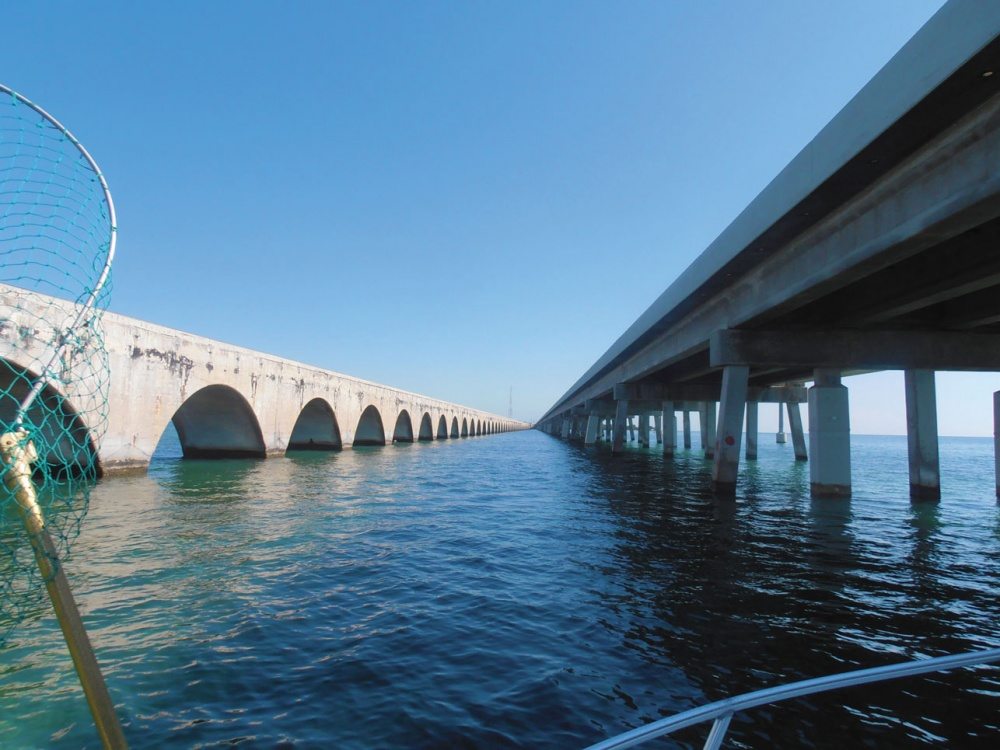Photo Courtesy of Big Pine Key Tarpon Fishing Lodge
Keys Tarpon Fishing At Bahia Honda Bridge
By CAM Staff
Between Big Pine Key and the state park at Bahia Honda Key, there are several miles of bridges that carry U.S. 1 over deep channels connecting the Straits of Florida and the Gulf of Mexico. In spring and early summer, the waters beneath Bahia Honda Bridge fill up with pods of migrating tarpon fishing, making it one of the best places in the world to hook up with the silver king.
Within a boat ride of mere minutes from the docks at Big Pine Key, anglers can be scouting between bridge pilings for flashing silver sides and rolling tarpon. When conditions are right, big pods of 50 to 100 fish pile in. Protected from the wind, boats anchor up-current and drift baits to fish in the 50- to 80-pound range, which is larger than most anglers even want to tangle with.
For the freshwater folks, the fishing is like drifting a nymph rig for trout, except the setup and the fish are enormous compared to what one would fish on a 5-weight fly rod. A blue crab is suspended beneath a cork or small balloon on 50-pound fluorocarbon leader and 30-pound braid spooled on an 8000-sized reel. The angler drifts the rig freely with the current and into pods of tarpon sometimes feeding visibly near the surface. When it’s on, there are captains who give a 100 percent guarantee the angler will hook up. A promise like that tells you just how good the fishing can be.
A blue crab is suspended beneath a cork or small balloon on 50-pound fluorocarbon leader and 30-pound braid spooled on an 8000-sized reel. The angler drifts the rig freely with the current and into pods of tarpon sometimes feeding visibly near the surface. When it’s on, there are captains who give a 100 percent guarantee the angler will hook up. A promise like that tells you just how good the fishing can be. Thousands of fish will be grouped up in and around the bridge when conditions are right, and the boats will be there to. It is an intense scene. As the anchor is cut loose, a boat chases a hooked tarpon in roaring current through the pilings with cheers of encouragement ringing out from other nearby anglers. The Lower Keys that include Big Pine are known for being laid-back, but this is by no means laid-back fishing.
And then there’s the worm hatch. During the summer tarpon migration, palolo worms also feel the need to move. The world’s most famous palolo worm hatch occurs at Bahia Honda. No one has it exactly figured out, but throughout the Keys tide and moon phases trigger thousands of 3-inch long burnt orange sea worms to wriggle to the surface to reproduce.
Tarpon go out of their minds when palolo worms swarm in the thousands. Giant fish can be seen gulping the little morsels on the surface and sometimes rising completely out of the water for them. Just to witness it is a spectacle. For those lucky enough to encounter it with a rod in hand, it is something else. Along with the backcountry, reef and offshore fishing, the tarpon migration and worm hatches are just a couple more examples of why fishing around Big Pine can be off the chain. The Lower Keys may promoted as the quiet side of the Florida Keys, but from the casting deck it can be adrenaline fueled experience.
